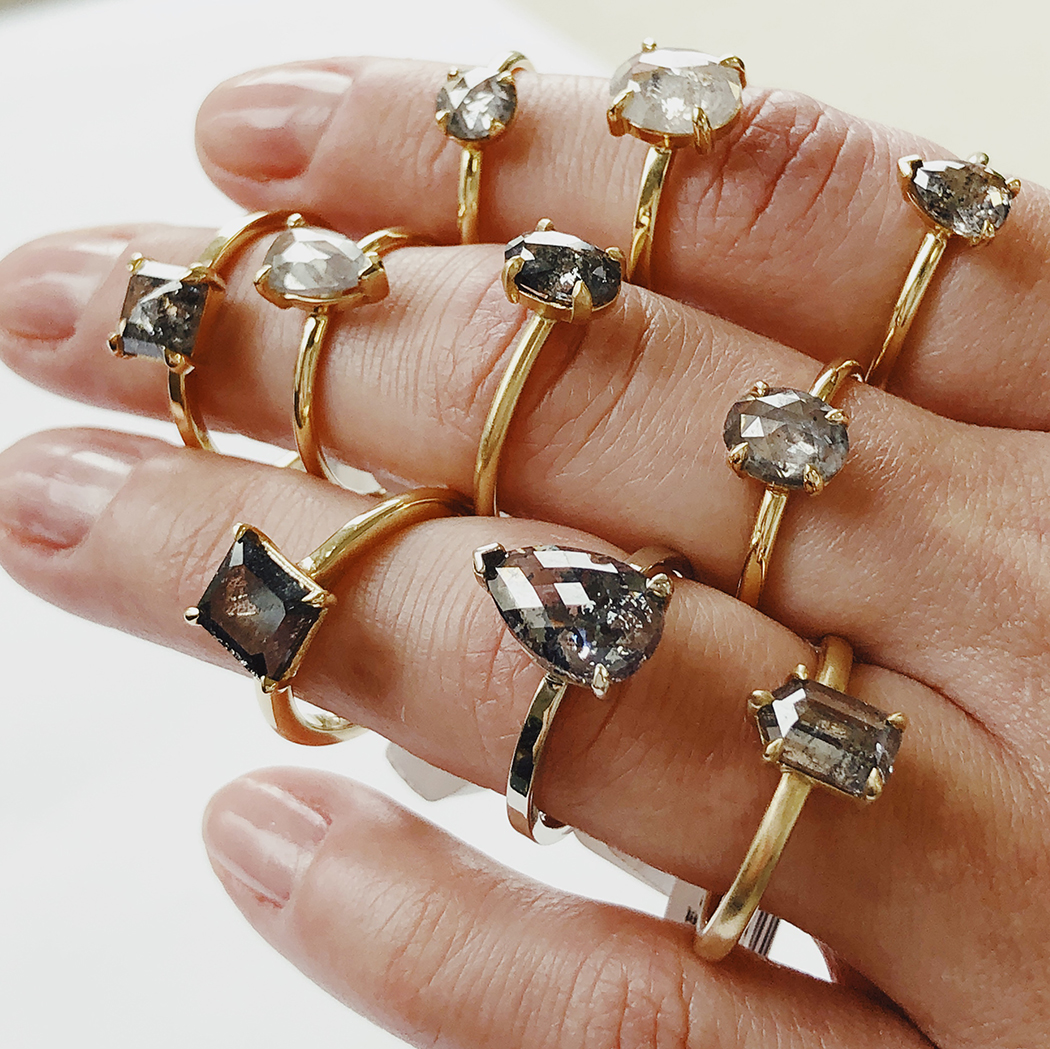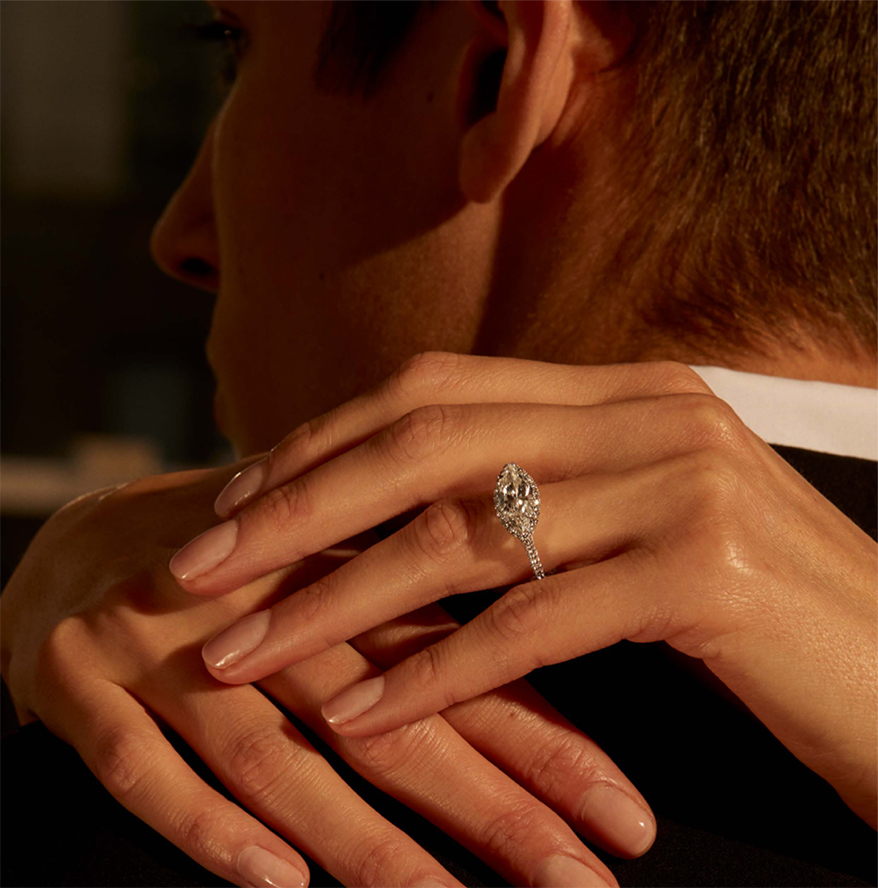 OR AT LEAST a decade, many jewelry retailers have been quietly seething or loudly complaining about the shopping habits of millennials. With that in mind, last fall, we asked our Big Survey retailer respondents to share just one thing that bothered them about Gen Y. They didn’t hold back. “You know the type. Oversensitive, phone obsessed, selfie-snapping, Friends-binge-watching, kombucha-guzzling, influencer-obsessed complainers,” wrote one. The most common answers fell along the lines of how much millennials think they know, a tendency to blindly trust what they see online, and their impatience. Retailers also decried millennials for a proclivity to buy jewelry online, a rapt reliance on Google reviews, and a preference for “delicate” jewelry.
OR AT LEAST a decade, many jewelry retailers have been quietly seething or loudly complaining about the shopping habits of millennials. With that in mind, last fall, we asked our Big Survey retailer respondents to share just one thing that bothered them about Gen Y. They didn’t hold back. “You know the type. Oversensitive, phone obsessed, selfie-snapping, Friends-binge-watching, kombucha-guzzling, influencer-obsessed complainers,” wrote one. The most common answers fell along the lines of how much millennials think they know, a tendency to blindly trust what they see online, and their impatience. Retailers also decried millennials for a proclivity to buy jewelry online, a rapt reliance on Google reviews, and a preference for “delicate” jewelry.
Respondents also said that for better or worse, millennial customers have forced jewelry store owners and managers to think differently, particularly when it comes to creating an experience and offering customization. “They never like something right out of the case,” said one perplexed store owner. “I swear if I pulled out exactly what they asked for, they would still want it different just so they can say they had it made custom.”
Well, here’s something to think about. The leading edge of the millennial generation, those born between 1981 and 1995, turn 40 this year. Gen Z, a group that is expected to out-millennial the millennials in some ways, is poised to become dominant in the all-important engagement ring shopper demographic. The oldest Gen Z is already 24. According to the U.S. Census Bureau, median age at first marriage for women in 2020 was 28, and for men, 30, including same-sex couples.
In some ways, for retailers who have thus far resisted developing omnichannel access and offering customization, it’s now or never. “If retailers are waiting for digital to go away, they will be disappointed,” warns luxury consultant Kathleen Cutler. “The requirement to work with Gen Z will be to have a digital presence.”
Gen Z, born roughly between 1997 and 2012, represents 32 percent of the world population. They’re active on social media, glued to their phones, already control roughly $44 billion in buying power and influence even more spending.
Advertisement
Like millennials, Gen Z will not be turning off their smartphones in your store. They won’t buy the first thing they see in your showcase. They will religiously read Google reviews, seek customization and are more likely than any past generation to ask about ethics, diversity and responsible sourcing.
“They don’t come in solo. These kids bring their mother, their girlfriend’s friend, their sister. That’s a good thing for us. It means this guy is ready to buy.” — MICHAEL KANOFF
Retail researchers also portray them as impatient. With an eight-second attention span, members of Gen Z will decide if something is worth their time in the blink of an eye. According to Oracle CrowdTwist, if they use their phones to call a business, they are 60 percent more likely than members of any other generation to hang up if they don’t speak to a person within 45 seconds. If they don’t have access to their smartphones for 15 minutes, they will become anxious.
Realize that any steps you take to prepare for Gen Z as your primary bridal shopper will also greatly benefit your business right now. In many ways the future has arrived, sped up in part by changes driven by the pandemic. Gordon Lawrie of Eidos in Santa Fe, NM, for example, says 90 percent of his in-store shoppers have researched the store online before they cross the threshold.
Becky Bettencourt of Blue River Diamonds in Peabody, MA, said 2020 felt like a turning point, a last chance for jewelry retailers to catch up to the shopping habits of their clients. “I think those who are digging their heels in and complaining are going to find themselves in the beginning of their steady decline,” she says.
Ben Smithee, CEO of consulting agency The Smithee Group, notes that the jewelry industry, which has been quite traditional and largely homogenous, has gotten away with doing business in the same way for a long period of time. “Ask yourself: What does gender, race, diversity and inclusion look like in a 2021 retail world?”
On an encouraging note, this next generation more likely than not will want to shop in a local store to support their communities. They may believe that small, independent businesses are cool, especially if that business appears to authentically share their values.
Sam Indelicato, director of culture for RDI Diamonds, says that according to a Bain & Co. study, 90 to 95 percent of Gen Z will want to buy diamonds in person, to see and touch their selection and find expert advice. You can win their business by personalizing the shopping experience, providing superior customer service and convenience, ensuring your inventory is well stocked, and providing a grading report that buyers can trust.
Gen Z grew up during the Great Recession and are coming of age during a global pandemic, so they are aware of how fickle finances can be. If they spend their money with you, they won’t be impulsive, and they will want to feel their purchase is worth it.

In general, observant retailers say, Gen Z won’t expect to get what you’re offering as cheaply as possible. If their research leads them to you, they will trust you as the expert. “I don’t see much of a pushback from Gen Z,” says Christine Lupo, a private retail jeweler in Washington D.C. “They’re less about the bargaining.”
Michael Kanoff, owner of Michael’s Jewelers in Yardley, PA, has noticed an evolution, too. “They’re doing the same thing that older millennials did, handing me their phone, showing me a picture of the ring,” Kanoff says. “But they are a lot easier to work with. Older millennials wanted to buy it on James Allen and Blue Nile and will ask if you can match the price. This younger group is less concerned about price, but they don’t want to compromise. They want it done exactly like they want it, but they do want to go to independent jewelry stores.”
Kanoff says they’re not just kicking the tires, either. “They don’t come in solo,” he says. “These kids bring their mother, their girlfriend’s friend, their sister. That’s a good thing for us. It means this guy is ready to buy.”
Smithee agrees that while many Gen Zers will prefer to shop with local independents, retailers who want to benefit from that tendency need to demonstrate unequivocally that they prequalify in the areas of good citizenship, including ethical business practices, sustainable high-quality goods, and generally “non-sleazy” behavior just to get on their radar.
Another qualifier is embracing technology, rather than just dancing around it. “The web is a profit center for you,” Smithee says. “If you’re not diving into it, you’re truly missing out on a jackpot of opportunity.”
Lily Mullen, fourth generation co-owner of Springer’s Jewelers in New England and a millennial herself, points out that as digital natives, members of Gen Z represent the first generation to have no knowledge of life without the internet. When they do visit you in person, they will have done the research to know that you have what they want in their budget. “There are not many surprises,” Mullen says.

Geometric rose-cut diamonds, salt and pepper diamonds and low-profile settings are popular at Malka Diamonds.
Mullen affirms that Gen Z is still looking for an in-store experience. “What’s clear is they will still want to have that relationship and they really, really appreciate it,” she says. “Our reviews almost always mention a salesperson by name.”
They are also looking for an expert who can verify as true what they have learned on their own. “We all know that just because there’s a lot of information out there doesn’t mean it’s good information,” she says.
They may value the level of privacy available with appointment-only jewelers. Many retailers who have experimented with appointment-only in the past year have not gone back to a walk-in business as COVID-19 restrictions have lifted, Cutler notes.
Another priority? Make sure there’s a well-lit area with an appealing background, a selfie studio or a wall for Gen Z to photograph any of the jewelry they try on and share with their friends.
Another notable change in the store, as mentioned by Anne Marie Marker of Rolland’s Jewelers in Libertyville, IL, is that it’s no longer a bad thing to have your cellphone on the sales floor, whether you are the shopper or the salesperson. “We’re focusing more on texting,” she says.

But to succeed with the youngest engagement ring shoppers, independent jewelers must take an omnichannel approach to sales and marketing in addition to providing a great experience in the store. The rewards can be significant, as Denise Oros of Linnea Jewelers in La Grange, IL, has found in the past pandemic year. Keeping up with the times by selling virtually makes her heart sing, she says. “I love being able to explain a CAD to completion without having someone in my store.
It is the new pre-shopping experience, so we do our best to make it fun and informative.”
It’s important to make social media, too, feel like the store experience.
“We’re lucky to have educated salespeople, but it’s our job to make sure that same experience is coming through on social media and on our website,” Mullens says. Rather than leaning on content from vendors, for example, Springer’s strategy is to highlight the staff and emphasize the shopping experience.
“Engage in chat on your website. Incorporate video sales calls with a try-on at home program. Have more touchpoints.” — KATHLEEN CUTLER
Consider the technical aspects of what constitutes a great experience. Some 60 percent of Gen Z won’t use an app or a website if it’s difficult to navigate, if it’s loading too slowly or if it doesn’t allow for in-app payment options. So, rather than just mobile friendly, think mobile first, and don’t use animation on your website, mobile or not, if it’s creating stumbling blocks.
The lines can blur between online and in-store shopping habits. In your store, if shoppers want to look around unassisted as they would if they were perusing your website, provide the kind of information they need for a self-guided tour and engage with them virtually, Smithee says. For example, ask the jewelry designer or brand to record a video telling the story of the piece and post a QR code so shoppers can scan it and hear the story on their own.
Store owners who hadn’t in the past engaged with QR codes may have become more comfortable with them since, during the pandemic, restaurants are using QR codes to link to their menus. Once someone does visit your website via a QR code, it’s simple to collect their information and follow up with them, too.
On the other hand, don’t leave shoppers alone to wander in your digital space unassisted if they’re looking for help. “There’s a tendency to have people walk to the digital cash register on their own,” Cutler says. “But when we leave people alone digitally and say, ‘Good luck, you’re on your own,’ lots of times they can talk themselves out of it.”
Engage in chat on your website. Incorporate video sales calls with a try-on at home program. Make sure you are ready to host virtual events and meetings by investing in optimal lighting and a dedicated video space. “Have more touchpoints,” Cutler says. “Say, ‘Let’s get on a call to go over the quote.’”
Pennsylvania-based Murphy Jewelers’ custom-designed website features a “did you notice?” section on product pages, which allows them to give customers a quick tip on the piece of jewelry — just like they would do across the case if they were inside the stores.
If you’re wondering how to find new bridal shoppers, begin by looking close to home. Stay connected with current clientele and realize their daughters and nieces will start to seek you out. In other words, rather than asking, “Where are bridal customers hanging out?” realize they are hanging out within your relationships, Cutler says. Gen Z will be heavily influenced not only by friends, but by parents and relatives, as well.
Advertisement
EXPECT AN EMPHASIS ON VALUES
G en Z will shop with brands that stand for something they consider important and align with their own self-image. “They have a personal brand, so what they buy really defines them,” Cutler says.
It will be very important for retailers to promote diversity and inclusiveness. These new buyers represent a unique, progressive and far more diverse group than previous buyers. “To connect with them, jewelers need to be inclusive in their messaging,” Indelicato says. “This means showing diversity in advertising and content and authentically welcoming unique views and love stories into their stores.”
Gen Z is going to require even more of the authenticity and transparency that some retailers might have resisted with millennials. “It’s easy to look at this generation as an outlier, but we’re all getting more and more values-driven,” Cutler says.
“What you are doing to prepare for future generations is beneficial for your current clients as well.”
Robert Donofrio hopes the next question young consumers begin asking retail jewelers will be: “Is this fair-mined gold in my wedding ring?”

The Natural Diamond Council identifies east-west set diamonds as a trend, such as in this setting by Kwiat.
Donofrio, a veteran in the jewelry industry, in 2019 launched a line of jewelry called Fortuna, largely as a wake-up call to the world that the mercury used in gold mining has been identified by the United Nations as a global pollutant. Before launching his line, Donofrio identified three artisanal mines, two in Peru, that were not using toxic chemicals in mining and began to buy the limited supply of gold being produced by those mines.
Donofrio says that while it is likely too expensive and difficult for independent retailers to purchase gold not associated with the release of toxic chemicals right now, they can begin by asking their suppliers and refiners about “level one” fair-mined gold that can ensure the social welfare of the mining communities.
One place to find education on industry issues that will matter to your clients is the Responsible Jewellery Council. The RJC can provide information about how its members are working to align their own efforts with the United Nation’s 17 Sustainable Development Goals, adopted by 193 countries in 2015, with the ambitious goal of becoming a road map for humanity.
Brandee Dallow, North America’s representative for the RJC, who spoke recently during a Jewelers of America Zoom webinar, urges retailers to begin a dialogue with their vendors about responsible sourcing. “More and more companies are expecting questions and answering them in a positive way,” she says. “Associating your company with doing the right thing is almost more important than the product you are selling. When you’re doing good, when you’re putting in management systems that make your company stronger and more transparent, report it and communicate it. Let people know.”
Dallow suggests small businesses can make a big impact immediately in promoting gender equality, for example, one of the Sustainable Development Goals, by ensuring equal representation on their staff and that their working environment is safe for and sensitive to everyone.
“Show the human pieces of the brand” — BEN SMITHEE
Small businesses can also quickly work toward a zero-carbon footprint by practicing recycling, using LED energy efficient lightbulbs and green energy and promoting the use of public transportation and local initiatives that support climate action. More information about these initiatives is available at responsiblejewellery.com.
Learn also about how the jewelry industry supports artisanal colored gem mining communities in Africa through non-profit organizations such as Gem Legacy (gemlegacy.org).
Once you find your niche, talk about how you support that aspect of the jewelry business to your clients. “Show the human pieces of the brand,” Smithee says.
Advertisement
WHAT DO THEY WANT?
G en Z is at an ideal age and life stage for jewelry brands to be introduced to them via social media and infuencer campaigns.
So far, Gen Z appears to have a bifurcated approach to jewelry, say Jason Dorsey and Denise Villa, Ph. D., the authors of Zconomy: How Gen Z Will Change The Future Of Business And What To Do About It. They purchase low-cost jewelry items so they can have options to accessorize their looks on social media posts. At the other end are affluent Gen Zers who are willing to splurge on luxury items.
It’s clear, though, that the biggest jewelry purchases for them lie in their future as their income increases and milestones, such as engagements, occur.
When it comes to engagements, Gen Z could continue the millennial trend of seeking out alternatives to traditionally mined diamonds for what they perceive as social-cause reasons and for cost efficiency.
But that won’t be a uniform decision. “You will have a sector that really values lab-grown diamonds, a sector that really values transparency from mined to store, and a sector that values antique and estate gemstones,” Cutler says. “Be willing to go niche.”
Don’t be overwhelmed by demands for customization. Realize that to a Gen Z shopper, changing a gemstone or adding an engraving adds value that outweighs its cost. “This generation is used to going to Starbucks and having a personalized, specific order,” Cutler says. “If part of your line allows for those little bits of customization, that will be popular.”

Lupo, who has operated a by-appointment-only retail business since 2012, agrees. “Anyone thinking they can move out of custom design is headed in the wrong direction,” she says. “They come in with their Pinterest board, but they still want something that is created for them.”
Ronnie Malka of Malka Diamonds in Portland, OR, says Gen Z clients are intrigued by unique shapes and colors. Geometric rose-cut diamonds, interesting bi-colored “parti” sapphires and a unique way of setting the stones, such as an east-west setting, are trending. They’re also requesting low-set profiles and separation of individual accent diamonds.
“Gen Z is a little more adventurous perhaps,” Malka says. “Both millennials and Gen Z are quite interested in the experience and in knowing more about the stone’s origin.”
Lupo has noticed that younger engagement ring shoppers care about the design and the experience more than traditional norms. “They don’t want traditional round brilliant cut diamonds, necessarily. They’re looking at rose cuts, salt-and-pepper diamonds and other stones altogether, like sapphires.”
If they do want diamonds, mined or lab-grown, they likely will want them to be closer to 2 carats than to the 1 carat considered aspirational 20 years ago.
Lupo has sold lab-grown diamond rings, too. She explains that while a customer may pay $10,000 for the diamond now, it may be worth half that when the technology improves. “A lot of jewelers are against it, but at the end of the day, if their budget is 10 grand and they want something that is really big, as long as they understand what they’re getting, that is a solution. It’s about whether or not the wearer is going to enjoy it and love it.”